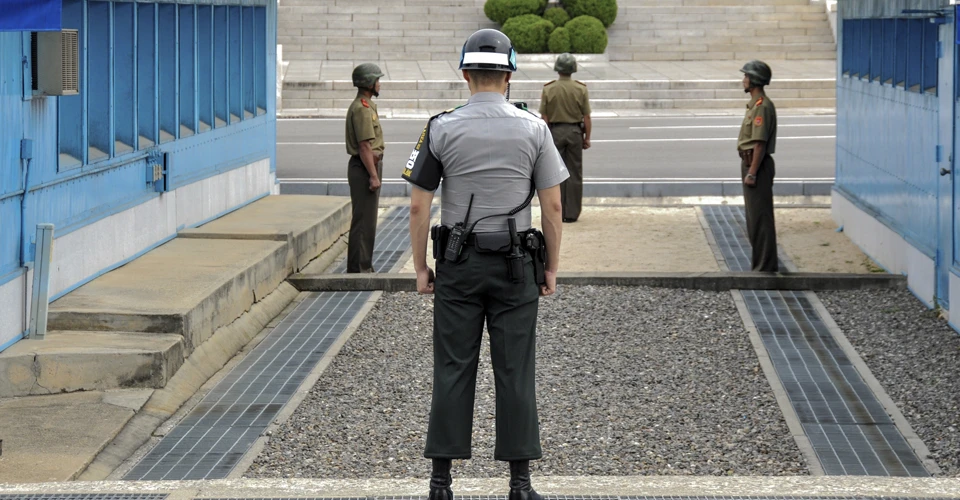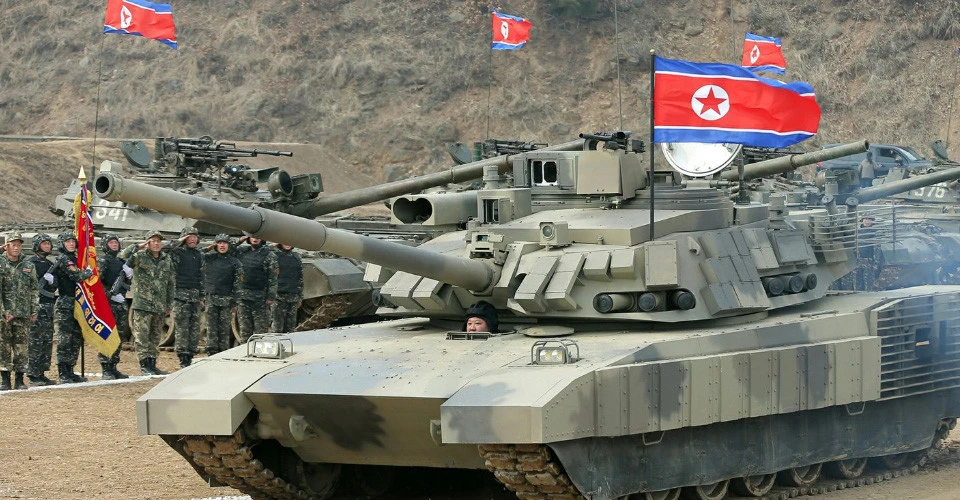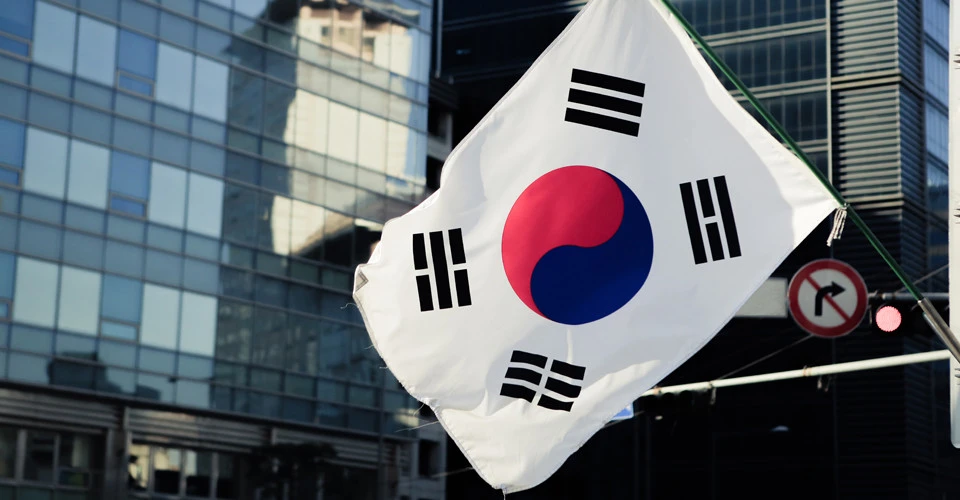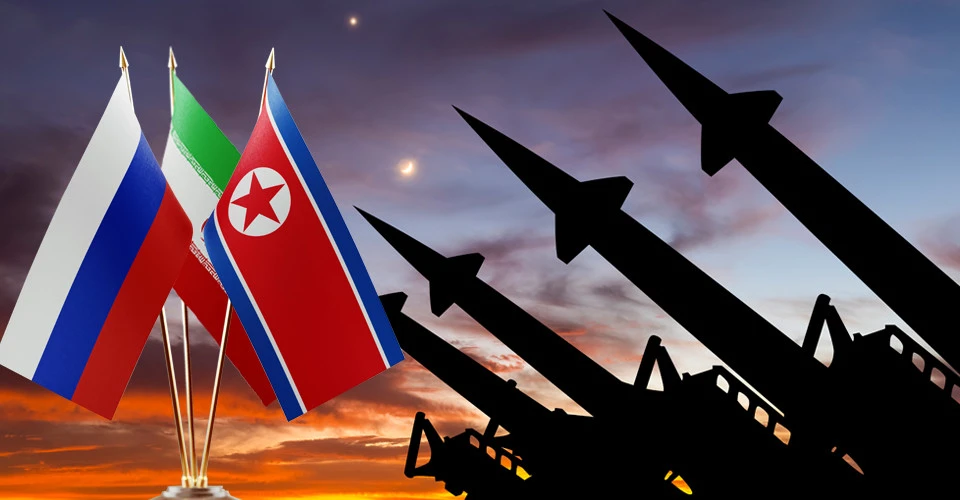Unfinished Korean War: how it shapes global security and Ukraine
global.espreso.tv
Wed, 20 Aug 2025 13:03:00 +0300

Content1. History of conflict on the turbulent peninsula: North vs. South Korea2. Escalation in recent years3. North Korea: Russia’s shadow ally in the war4. South Korea: Western ally and indirect partner of Ukraine5. Threats from a new axis: Russia – China – North Korea – IranHistory of conflict on the turbulent peninsula: North vs. South Korea Two neighboring worlds, North and South Korea, are divided not only by a border but also by a history that has shaped their relations for over seven decades. The split occurred after World War II, when Korea, which had been under Japanese rule for more than 35 years, was divided along the 38th parallel: the north became a Soviet sphere of influence, and the south an American one. In December 1945, U.S. and Soviet representatives signed an agreement on the temporary governance of the country. Although this was formally intended as a temporary measure, by 1948 two states had emerged on the Korean Peninsula: the communist DPRK, led by Kim Il-sung, and the capitalist Republic of Korea, led by Syngman Rhee. Meanwhile, the DPRK repeatedly expressed a desire to rule the entire peninsula and made plans for an attack.And in 1950, something happened that cemented the division. The confrontation between the north and south escalated into open conflict — the Korean War. North Korea initiated hostilities, of course, with Soviet support. For the U.S. and other Western countries, this development was quite unexpected, but they did not leave South Korea to fight alone.With differing advantages, dead ends, and negotiations, the war lasted three years. It claimed the lives of over two million people, leaving the peninsula in ruins. It ended not with a peace treaty but with the 1953 armistice agreement, which maintained the status quo and established a demilitarized zone.Since then, relations between the two Koreas have fluctuated between hostility and attempts at reconciliation. The Cold War made their fates hostages to global confrontation: the North aligned with the USSR and China, while the South aligned with the U.S. and the Western world.Only on December 13, 1991, through UN mediation, did the DPRK and the Republic of Korea sign the Agreement on Reconciliation, Non-Aggression, Cooperation, and Exchanges. Under this agreement, both Korean states effectively recognized each other’s sovereignty and independence.However, this truce did not last long, and for years the two countries have been swinging back and forth and testing each other's strength. After hopes for rapprochement in the late 20th and early 21st centuries, tensions flared again in 2010, caused by North Korea: it torpedoed a South Korean ship and shelled Yeonpyeongdo with artillery. In 2013, the DPRK government even annulled the non-aggression pact with South Korea.Since then, each wave of warming has inevitably been followed by new crises, military incidents, or escalations in rhetoric. This pendulum, from hope to mistrust, still defines the basis of relations between North and South. At the same time, the countries have so far managed to maintain a “bad peace,” avoiding a return to open war.Escalation in recent years
Two neighboring worlds, North and South Korea, are divided not only by a border but also by a history that has shaped their relations for over seven decades. The split occurred after World War II, when Korea, which had been under Japanese rule for more than 35 years, was divided along the 38th parallel: the north became a Soviet sphere of influence, and the south an American one. In December 1945, U.S. and Soviet representatives signed an agreement on the temporary governance of the country. Although this was formally intended as a temporary measure, by 1948 two states had emerged on the Korean Peninsula: the communist DPRK, led by Kim Il-sung, and the capitalist Republic of Korea, led by Syngman Rhee. Meanwhile, the DPRK repeatedly expressed a desire to rule the entire peninsula and made plans for an attack.And in 1950, something happened that cemented the division. The confrontation between the north and south escalated into open conflict — the Korean War. North Korea initiated hostilities, of course, with Soviet support. For the U.S. and other Western countries, this development was quite unexpected, but they did not leave South Korea to fight alone.With differing advantages, dead ends, and negotiations, the war lasted three years. It claimed the lives of over two million people, leaving the peninsula in ruins. It ended not with a peace treaty but with the 1953 armistice agreement, which maintained the status quo and established a demilitarized zone.Since then, relations between the two Koreas have fluctuated between hostility and attempts at reconciliation. The Cold War made their fates hostages to global confrontation: the North aligned with the USSR and China, while the South aligned with the U.S. and the Western world.Only on December 13, 1991, through UN mediation, did the DPRK and the Republic of Korea sign the Agreement on Reconciliation, Non-Aggression, Cooperation, and Exchanges. Under this agreement, both Korean states effectively recognized each other’s sovereignty and independence.However, this truce did not last long, and for years the two countries have been swinging back and forth and testing each other's strength. After hopes for rapprochement in the late 20th and early 21st centuries, tensions flared again in 2010, caused by North Korea: it torpedoed a South Korean ship and shelled Yeonpyeongdo with artillery. In 2013, the DPRK government even annulled the non-aggression pact with South Korea.Since then, each wave of warming has inevitably been followed by new crises, military incidents, or escalations in rhetoric. This pendulum, from hope to mistrust, still defines the basis of relations between North and South. At the same time, the countries have so far managed to maintain a “bad peace,” avoiding a return to open war.Escalation in recent years After the last brief wave of optimism in 2018–2019, relations between North and South Korea declined again. The turning point came in 2019, when talks between the U.S. and the DPRK in Hanoi were deemed a failure by Pyongyang. Kim Jong Un considered Washington’s position unacceptable, and subsequent initiatives from Seoul lost their purpose. Since then, the North has returned to a policy of isolation and demonstrative provocations.In 2020, tensions sharply escalated: Pyongyang blew up the inter-Korean liaison office in Kaesong, a symbol of cooperation established during the Sunshine Policy. This occurred amid North Korean accusations that Seoul was sending propaganda leaflets across the border, and it once again signaled the end of dialogue.Since 2021, tensions have only increased. North Korea began conducting numerous missile tests, including intercontinental ballistic missile launches capable of reaching the U.S. Dozens of different types of missiles were launched, some falling near South Korean and Japanese territorial waters.Throughout 2023–2024, Pyongyang further intensified its rhetoric. Kim Jong Un ended 2023 with a high-profile address to the plenary of the Workers’ Party of Korea, rejecting the possibility of peaceful reunification with South Korea and describing their relationship as one “between two hostile countries.” He also emphasized North Korea’s so-called nuclear statehood. In response, the South conducted more active military exercises with the U.S. and Japan. The atmosphere on the peninsula looks increasingly explosive. Both North Korea and South Korea have put their troops on high alert.The climax came in 2025: levels of mutual hostility reached their highest point in decades. At the end of July, North Korea officially refused to normalize relations with Seoul. Meanwhile, on August 18, U.S. and South Korean forces began their annual joint exercises amid potential threats from the DPRK. In response, Kim Jong Un ordered an increase in Pyongyang’s nuclear arsenal, calling the exercises “a clear demonstration of the intent of the U.S. and South Korea to openly show hostility and a confrontational policy toward the DPRK.”At the same time, North Korea is cooperating more closely with Russia and China, using their support as a counterbalance to the Western bloc. South Korea, in turn, is strengthening defense alliances with the U.S. and Japan. This also ties back to 2022, when Russia launched its full-scale armed aggression against Ukraine: in line with this pattern, the two parts of the Korean Peninsula are similarly divided in their support.North Korea: Russia’s shadow ally in the war
After the last brief wave of optimism in 2018–2019, relations between North and South Korea declined again. The turning point came in 2019, when talks between the U.S. and the DPRK in Hanoi were deemed a failure by Pyongyang. Kim Jong Un considered Washington’s position unacceptable, and subsequent initiatives from Seoul lost their purpose. Since then, the North has returned to a policy of isolation and demonstrative provocations.In 2020, tensions sharply escalated: Pyongyang blew up the inter-Korean liaison office in Kaesong, a symbol of cooperation established during the Sunshine Policy. This occurred amid North Korean accusations that Seoul was sending propaganda leaflets across the border, and it once again signaled the end of dialogue.Since 2021, tensions have only increased. North Korea began conducting numerous missile tests, including intercontinental ballistic missile launches capable of reaching the U.S. Dozens of different types of missiles were launched, some falling near South Korean and Japanese territorial waters.Throughout 2023–2024, Pyongyang further intensified its rhetoric. Kim Jong Un ended 2023 with a high-profile address to the plenary of the Workers’ Party of Korea, rejecting the possibility of peaceful reunification with South Korea and describing their relationship as one “between two hostile countries.” He also emphasized North Korea’s so-called nuclear statehood. In response, the South conducted more active military exercises with the U.S. and Japan. The atmosphere on the peninsula looks increasingly explosive. Both North Korea and South Korea have put their troops on high alert.The climax came in 2025: levels of mutual hostility reached their highest point in decades. At the end of July, North Korea officially refused to normalize relations with Seoul. Meanwhile, on August 18, U.S. and South Korean forces began their annual joint exercises amid potential threats from the DPRK. In response, Kim Jong Un ordered an increase in Pyongyang’s nuclear arsenal, calling the exercises “a clear demonstration of the intent of the U.S. and South Korea to openly show hostility and a confrontational policy toward the DPRK.”At the same time, North Korea is cooperating more closely with Russia and China, using their support as a counterbalance to the Western bloc. South Korea, in turn, is strengthening defense alliances with the U.S. and Japan. This also ties back to 2022, when Russia launched its full-scale armed aggression against Ukraine: in line with this pattern, the two parts of the Korean Peninsula are similarly divided in their support.North Korea: Russia’s shadow ally in the war Since the start of Russia’s full-scale invasion of Ukraine, North Korea has been one of the few countries to openly support Moscow. Pyongyang recognized the so-called Donetsk People’s Republic and Luhansk People’s Republic as “independent,” effectively siding with the aggressor. This stance was not unexpected: both regimes face international isolation, and for Kim Jong Un, closer ties with Moscow offered a chance to gain political and economic benefits.According to South Korean military intelligence, North Korea continues to actively support Russia’s war in Ukraine by supplying weapons and artillery ammunition. In addition to weaponry, since October of last year, Pyongyang has sent about 13,000 military personnel to Russia, who are participating in combat operations alongside Moscow.This military partnership allows Russia to partially offset the depletion of its own arsenals, while Pyongyang, in turn, receives technological assistance from Moscow to develop its missile and, possibly, nuclear programs.Politically, North Korea seeks to present itself not only as a junior partner of Russia but also as an independent player opposing the “West.” For Ukraine, this cooperation poses a real threat: North Korean shells and missiles are already being used on the battlefield, and the Moscow-Pyongyang alliance means the war is increasingly moving beyond a European context, becoming part of a global confrontation between authoritarian regimes and the West.South Korea: Western ally and indirect partner of Ukraine
Since the start of Russia’s full-scale invasion of Ukraine, North Korea has been one of the few countries to openly support Moscow. Pyongyang recognized the so-called Donetsk People’s Republic and Luhansk People’s Republic as “independent,” effectively siding with the aggressor. This stance was not unexpected: both regimes face international isolation, and for Kim Jong Un, closer ties with Moscow offered a chance to gain political and economic benefits.According to South Korean military intelligence, North Korea continues to actively support Russia’s war in Ukraine by supplying weapons and artillery ammunition. In addition to weaponry, since October of last year, Pyongyang has sent about 13,000 military personnel to Russia, who are participating in combat operations alongside Moscow.This military partnership allows Russia to partially offset the depletion of its own arsenals, while Pyongyang, in turn, receives technological assistance from Moscow to develop its missile and, possibly, nuclear programs.Politically, North Korea seeks to present itself not only as a junior partner of Russia but also as an independent player opposing the “West.” For Ukraine, this cooperation poses a real threat: North Korean shells and missiles are already being used on the battlefield, and the Moscow-Pyongyang alliance means the war is increasingly moving beyond a European context, becoming part of a global confrontation between authoritarian regimes and the West.South Korea: Western ally and indirect partner of Ukraine In contrast to the North, South Korea condemned Russia’s aggression against Ukraine from the very first days of the full-scale invasion and joined international sanctions. This was not an easy step for Seoul: historically, the country had approached Russia cautiously to avoid escalating tensions on the peninsula. However, the scale of Russia’s aggression and its close cooperation with Pyongyang forced South Korea to abandon neutrality.Officially, Seoul stated that it would not supply lethal weapons to Ukraine, fearing direct escalation from Russia and North Korea. At the same time, South Korea found other ways to support Kyiv, providing financial, humanitarian, technical, and non-lethal assistance, including body armor, helmets, demining vehicles, and other equipment. It also actively participates in reconstruction projects and acts as a technology partner.For Seoul, supporting Ukraine also carries its own strategic significance. By helping Ukrainians, South Korea simultaneously strengthens its own security and expands its network of global allies. Due to global demand for weapons, driven by Russia’s full-scale invasion, South Korea’s defense industry profits have increased. Moreover, drone technologies tested on the Ukrainian front are being adopted for domestic use, giving Seoul a deeper understanding of new axes of warfare that could unfold using modern weaponry.Threats from a new axis: Russia – China – North Korea – Iran
In contrast to the North, South Korea condemned Russia’s aggression against Ukraine from the very first days of the full-scale invasion and joined international sanctions. This was not an easy step for Seoul: historically, the country had approached Russia cautiously to avoid escalating tensions on the peninsula. However, the scale of Russia’s aggression and its close cooperation with Pyongyang forced South Korea to abandon neutrality.Officially, Seoul stated that it would not supply lethal weapons to Ukraine, fearing direct escalation from Russia and North Korea. At the same time, South Korea found other ways to support Kyiv, providing financial, humanitarian, technical, and non-lethal assistance, including body armor, helmets, demining vehicles, and other equipment. It also actively participates in reconstruction projects and acts as a technology partner.For Seoul, supporting Ukraine also carries its own strategic significance. By helping Ukrainians, South Korea simultaneously strengthens its own security and expands its network of global allies. Due to global demand for weapons, driven by Russia’s full-scale invasion, South Korea’s defense industry profits have increased. Moreover, drone technologies tested on the Ukrainian front are being adopted for domestic use, giving Seoul a deeper understanding of new axes of warfare that could unfold using modern weaponry.Threats from a new axis: Russia – China – North Korea – Iran In 2024, analysts began speaking of an informal alliance of authoritarian states, called CRINK — China, Russia, Iran, and North Korea. Its goal is to counter Western influence and create an alternative multipolar world order.Although these countries do not have an official military alliance, they coordinate actions in economic, military, and diplomatic spheres. China has become Russia’s largest trading partner and supplies dual-use goods that can be used for military purposes. Iran provides Russia with drones and military equipment, while North Korea supplies ammunition, missiles, and even sends its troops to participate in combat operations alongside Moscow.Despite this, the alliance has significant vulnerabilities. Iran has suffered serious strikes on military targets and substantial damage to its nuclear and missile capabilities, limiting its ability to support CRINK partners. China, engaged in a trade and technology war with the United States, is acting cautiously and waiting, avoiding open confrontation. Russia, meanwhile, is focused on the war in Ukraine and increasingly depends on North Korea’s assistance in supplying ammunition and military resources to the front.In this context, South Korea could become a key player in countering the new “axis.” As a U.S. ally, Seoul is actively strengthening its defense, participating in international sanctions against Russia and Iran, and providing humanitarian, technical, and indirect military assistance to Ukraine. Rising threats from CRINK may encourage South Korea to engage more actively in international coordination among democratic countries and enhance its role in global security.
In 2024, analysts began speaking of an informal alliance of authoritarian states, called CRINK — China, Russia, Iran, and North Korea. Its goal is to counter Western influence and create an alternative multipolar world order.Although these countries do not have an official military alliance, they coordinate actions in economic, military, and diplomatic spheres. China has become Russia’s largest trading partner and supplies dual-use goods that can be used for military purposes. Iran provides Russia with drones and military equipment, while North Korea supplies ammunition, missiles, and even sends its troops to participate in combat operations alongside Moscow.Despite this, the alliance has significant vulnerabilities. Iran has suffered serious strikes on military targets and substantial damage to its nuclear and missile capabilities, limiting its ability to support CRINK partners. China, engaged in a trade and technology war with the United States, is acting cautiously and waiting, avoiding open confrontation. Russia, meanwhile, is focused on the war in Ukraine and increasingly depends on North Korea’s assistance in supplying ammunition and military resources to the front.In this context, South Korea could become a key player in countering the new “axis.” As a U.S. ally, Seoul is actively strengthening its defense, participating in international sanctions against Russia and Iran, and providing humanitarian, technical, and indirect military assistance to Ukraine. Rising threats from CRINK may encourage South Korea to engage more actively in international coordination among democratic countries and enhance its role in global security.
 Two neighboring worlds, North and South Korea, are divided not only by a border but also by a history that has shaped their relations for over seven decades. The split occurred after World War II, when Korea, which had been under Japanese rule for more than 35 years, was divided along the 38th parallel: the north became a Soviet sphere of influence, and the south an American one. In December 1945, U.S. and Soviet representatives signed an agreement on the temporary governance of the country. Although this was formally intended as a temporary measure, by 1948 two states had emerged on the Korean Peninsula: the communist DPRK, led by Kim Il-sung, and the capitalist Republic of Korea, led by Syngman Rhee. Meanwhile, the DPRK repeatedly expressed a desire to rule the entire peninsula and made plans for an attack.And in 1950, something happened that cemented the division. The confrontation between the north and south escalated into open conflict — the Korean War. North Korea initiated hostilities, of course, with Soviet support. For the U.S. and other Western countries, this development was quite unexpected, but they did not leave South Korea to fight alone.With differing advantages, dead ends, and negotiations, the war lasted three years. It claimed the lives of over two million people, leaving the peninsula in ruins. It ended not with a peace treaty but with the 1953 armistice agreement, which maintained the status quo and established a demilitarized zone.Since then, relations between the two Koreas have fluctuated between hostility and attempts at reconciliation. The Cold War made their fates hostages to global confrontation: the North aligned with the USSR and China, while the South aligned with the U.S. and the Western world.Only on December 13, 1991, through UN mediation, did the DPRK and the Republic of Korea sign the Agreement on Reconciliation, Non-Aggression, Cooperation, and Exchanges. Under this agreement, both Korean states effectively recognized each other’s sovereignty and independence.However, this truce did not last long, and for years the two countries have been swinging back and forth and testing each other's strength. After hopes for rapprochement in the late 20th and early 21st centuries, tensions flared again in 2010, caused by North Korea: it torpedoed a South Korean ship and shelled Yeonpyeongdo with artillery. In 2013, the DPRK government even annulled the non-aggression pact with South Korea.Since then, each wave of warming has inevitably been followed by new crises, military incidents, or escalations in rhetoric. This pendulum, from hope to mistrust, still defines the basis of relations between North and South. At the same time, the countries have so far managed to maintain a “bad peace,” avoiding a return to open war.Escalation in recent years
Two neighboring worlds, North and South Korea, are divided not only by a border but also by a history that has shaped their relations for over seven decades. The split occurred after World War II, when Korea, which had been under Japanese rule for more than 35 years, was divided along the 38th parallel: the north became a Soviet sphere of influence, and the south an American one. In December 1945, U.S. and Soviet representatives signed an agreement on the temporary governance of the country. Although this was formally intended as a temporary measure, by 1948 two states had emerged on the Korean Peninsula: the communist DPRK, led by Kim Il-sung, and the capitalist Republic of Korea, led by Syngman Rhee. Meanwhile, the DPRK repeatedly expressed a desire to rule the entire peninsula and made plans for an attack.And in 1950, something happened that cemented the division. The confrontation between the north and south escalated into open conflict — the Korean War. North Korea initiated hostilities, of course, with Soviet support. For the U.S. and other Western countries, this development was quite unexpected, but they did not leave South Korea to fight alone.With differing advantages, dead ends, and negotiations, the war lasted three years. It claimed the lives of over two million people, leaving the peninsula in ruins. It ended not with a peace treaty but with the 1953 armistice agreement, which maintained the status quo and established a demilitarized zone.Since then, relations between the two Koreas have fluctuated between hostility and attempts at reconciliation. The Cold War made their fates hostages to global confrontation: the North aligned with the USSR and China, while the South aligned with the U.S. and the Western world.Only on December 13, 1991, through UN mediation, did the DPRK and the Republic of Korea sign the Agreement on Reconciliation, Non-Aggression, Cooperation, and Exchanges. Under this agreement, both Korean states effectively recognized each other’s sovereignty and independence.However, this truce did not last long, and for years the two countries have been swinging back and forth and testing each other's strength. After hopes for rapprochement in the late 20th and early 21st centuries, tensions flared again in 2010, caused by North Korea: it torpedoed a South Korean ship and shelled Yeonpyeongdo with artillery. In 2013, the DPRK government even annulled the non-aggression pact with South Korea.Since then, each wave of warming has inevitably been followed by new crises, military incidents, or escalations in rhetoric. This pendulum, from hope to mistrust, still defines the basis of relations between North and South. At the same time, the countries have so far managed to maintain a “bad peace,” avoiding a return to open war.Escalation in recent years After the last brief wave of optimism in 2018–2019, relations between North and South Korea declined again. The turning point came in 2019, when talks between the U.S. and the DPRK in Hanoi were deemed a failure by Pyongyang. Kim Jong Un considered Washington’s position unacceptable, and subsequent initiatives from Seoul lost their purpose. Since then, the North has returned to a policy of isolation and demonstrative provocations.In 2020, tensions sharply escalated: Pyongyang blew up the inter-Korean liaison office in Kaesong, a symbol of cooperation established during the Sunshine Policy. This occurred amid North Korean accusations that Seoul was sending propaganda leaflets across the border, and it once again signaled the end of dialogue.Since 2021, tensions have only increased. North Korea began conducting numerous missile tests, including intercontinental ballistic missile launches capable of reaching the U.S. Dozens of different types of missiles were launched, some falling near South Korean and Japanese territorial waters.Throughout 2023–2024, Pyongyang further intensified its rhetoric. Kim Jong Un ended 2023 with a high-profile address to the plenary of the Workers’ Party of Korea, rejecting the possibility of peaceful reunification with South Korea and describing their relationship as one “between two hostile countries.” He also emphasized North Korea’s so-called nuclear statehood. In response, the South conducted more active military exercises with the U.S. and Japan. The atmosphere on the peninsula looks increasingly explosive. Both North Korea and South Korea have put their troops on high alert.The climax came in 2025: levels of mutual hostility reached their highest point in decades. At the end of July, North Korea officially refused to normalize relations with Seoul. Meanwhile, on August 18, U.S. and South Korean forces began their annual joint exercises amid potential threats from the DPRK. In response, Kim Jong Un ordered an increase in Pyongyang’s nuclear arsenal, calling the exercises “a clear demonstration of the intent of the U.S. and South Korea to openly show hostility and a confrontational policy toward the DPRK.”At the same time, North Korea is cooperating more closely with Russia and China, using their support as a counterbalance to the Western bloc. South Korea, in turn, is strengthening defense alliances with the U.S. and Japan. This also ties back to 2022, when Russia launched its full-scale armed aggression against Ukraine: in line with this pattern, the two parts of the Korean Peninsula are similarly divided in their support.North Korea: Russia’s shadow ally in the war
After the last brief wave of optimism in 2018–2019, relations between North and South Korea declined again. The turning point came in 2019, when talks between the U.S. and the DPRK in Hanoi were deemed a failure by Pyongyang. Kim Jong Un considered Washington’s position unacceptable, and subsequent initiatives from Seoul lost their purpose. Since then, the North has returned to a policy of isolation and demonstrative provocations.In 2020, tensions sharply escalated: Pyongyang blew up the inter-Korean liaison office in Kaesong, a symbol of cooperation established during the Sunshine Policy. This occurred amid North Korean accusations that Seoul was sending propaganda leaflets across the border, and it once again signaled the end of dialogue.Since 2021, tensions have only increased. North Korea began conducting numerous missile tests, including intercontinental ballistic missile launches capable of reaching the U.S. Dozens of different types of missiles were launched, some falling near South Korean and Japanese territorial waters.Throughout 2023–2024, Pyongyang further intensified its rhetoric. Kim Jong Un ended 2023 with a high-profile address to the plenary of the Workers’ Party of Korea, rejecting the possibility of peaceful reunification with South Korea and describing their relationship as one “between two hostile countries.” He also emphasized North Korea’s so-called nuclear statehood. In response, the South conducted more active military exercises with the U.S. and Japan. The atmosphere on the peninsula looks increasingly explosive. Both North Korea and South Korea have put their troops on high alert.The climax came in 2025: levels of mutual hostility reached their highest point in decades. At the end of July, North Korea officially refused to normalize relations with Seoul. Meanwhile, on August 18, U.S. and South Korean forces began their annual joint exercises amid potential threats from the DPRK. In response, Kim Jong Un ordered an increase in Pyongyang’s nuclear arsenal, calling the exercises “a clear demonstration of the intent of the U.S. and South Korea to openly show hostility and a confrontational policy toward the DPRK.”At the same time, North Korea is cooperating more closely with Russia and China, using their support as a counterbalance to the Western bloc. South Korea, in turn, is strengthening defense alliances with the U.S. and Japan. This also ties back to 2022, when Russia launched its full-scale armed aggression against Ukraine: in line with this pattern, the two parts of the Korean Peninsula are similarly divided in their support.North Korea: Russia’s shadow ally in the war Since the start of Russia’s full-scale invasion of Ukraine, North Korea has been one of the few countries to openly support Moscow. Pyongyang recognized the so-called Donetsk People’s Republic and Luhansk People’s Republic as “independent,” effectively siding with the aggressor. This stance was not unexpected: both regimes face international isolation, and for Kim Jong Un, closer ties with Moscow offered a chance to gain political and economic benefits.According to South Korean military intelligence, North Korea continues to actively support Russia’s war in Ukraine by supplying weapons and artillery ammunition. In addition to weaponry, since October of last year, Pyongyang has sent about 13,000 military personnel to Russia, who are participating in combat operations alongside Moscow.This military partnership allows Russia to partially offset the depletion of its own arsenals, while Pyongyang, in turn, receives technological assistance from Moscow to develop its missile and, possibly, nuclear programs.Politically, North Korea seeks to present itself not only as a junior partner of Russia but also as an independent player opposing the “West.” For Ukraine, this cooperation poses a real threat: North Korean shells and missiles are already being used on the battlefield, and the Moscow-Pyongyang alliance means the war is increasingly moving beyond a European context, becoming part of a global confrontation between authoritarian regimes and the West.South Korea: Western ally and indirect partner of Ukraine
Since the start of Russia’s full-scale invasion of Ukraine, North Korea has been one of the few countries to openly support Moscow. Pyongyang recognized the so-called Donetsk People’s Republic and Luhansk People’s Republic as “independent,” effectively siding with the aggressor. This stance was not unexpected: both regimes face international isolation, and for Kim Jong Un, closer ties with Moscow offered a chance to gain political and economic benefits.According to South Korean military intelligence, North Korea continues to actively support Russia’s war in Ukraine by supplying weapons and artillery ammunition. In addition to weaponry, since October of last year, Pyongyang has sent about 13,000 military personnel to Russia, who are participating in combat operations alongside Moscow.This military partnership allows Russia to partially offset the depletion of its own arsenals, while Pyongyang, in turn, receives technological assistance from Moscow to develop its missile and, possibly, nuclear programs.Politically, North Korea seeks to present itself not only as a junior partner of Russia but also as an independent player opposing the “West.” For Ukraine, this cooperation poses a real threat: North Korean shells and missiles are already being used on the battlefield, and the Moscow-Pyongyang alliance means the war is increasingly moving beyond a European context, becoming part of a global confrontation between authoritarian regimes and the West.South Korea: Western ally and indirect partner of Ukraine In contrast to the North, South Korea condemned Russia’s aggression against Ukraine from the very first days of the full-scale invasion and joined international sanctions. This was not an easy step for Seoul: historically, the country had approached Russia cautiously to avoid escalating tensions on the peninsula. However, the scale of Russia’s aggression and its close cooperation with Pyongyang forced South Korea to abandon neutrality.Officially, Seoul stated that it would not supply lethal weapons to Ukraine, fearing direct escalation from Russia and North Korea. At the same time, South Korea found other ways to support Kyiv, providing financial, humanitarian, technical, and non-lethal assistance, including body armor, helmets, demining vehicles, and other equipment. It also actively participates in reconstruction projects and acts as a technology partner.For Seoul, supporting Ukraine also carries its own strategic significance. By helping Ukrainians, South Korea simultaneously strengthens its own security and expands its network of global allies. Due to global demand for weapons, driven by Russia’s full-scale invasion, South Korea’s defense industry profits have increased. Moreover, drone technologies tested on the Ukrainian front are being adopted for domestic use, giving Seoul a deeper understanding of new axes of warfare that could unfold using modern weaponry.Threats from a new axis: Russia – China – North Korea – Iran
In contrast to the North, South Korea condemned Russia’s aggression against Ukraine from the very first days of the full-scale invasion and joined international sanctions. This was not an easy step for Seoul: historically, the country had approached Russia cautiously to avoid escalating tensions on the peninsula. However, the scale of Russia’s aggression and its close cooperation with Pyongyang forced South Korea to abandon neutrality.Officially, Seoul stated that it would not supply lethal weapons to Ukraine, fearing direct escalation from Russia and North Korea. At the same time, South Korea found other ways to support Kyiv, providing financial, humanitarian, technical, and non-lethal assistance, including body armor, helmets, demining vehicles, and other equipment. It also actively participates in reconstruction projects and acts as a technology partner.For Seoul, supporting Ukraine also carries its own strategic significance. By helping Ukrainians, South Korea simultaneously strengthens its own security and expands its network of global allies. Due to global demand for weapons, driven by Russia’s full-scale invasion, South Korea’s defense industry profits have increased. Moreover, drone technologies tested on the Ukrainian front are being adopted for domestic use, giving Seoul a deeper understanding of new axes of warfare that could unfold using modern weaponry.Threats from a new axis: Russia – China – North Korea – Iran In 2024, analysts began speaking of an informal alliance of authoritarian states, called CRINK — China, Russia, Iran, and North Korea. Its goal is to counter Western influence and create an alternative multipolar world order.Although these countries do not have an official military alliance, they coordinate actions in economic, military, and diplomatic spheres. China has become Russia’s largest trading partner and supplies dual-use goods that can be used for military purposes. Iran provides Russia with drones and military equipment, while North Korea supplies ammunition, missiles, and even sends its troops to participate in combat operations alongside Moscow.Despite this, the alliance has significant vulnerabilities. Iran has suffered serious strikes on military targets and substantial damage to its nuclear and missile capabilities, limiting its ability to support CRINK partners. China, engaged in a trade and technology war with the United States, is acting cautiously and waiting, avoiding open confrontation. Russia, meanwhile, is focused on the war in Ukraine and increasingly depends on North Korea’s assistance in supplying ammunition and military resources to the front.In this context, South Korea could become a key player in countering the new “axis.” As a U.S. ally, Seoul is actively strengthening its defense, participating in international sanctions against Russia and Iran, and providing humanitarian, technical, and indirect military assistance to Ukraine. Rising threats from CRINK may encourage South Korea to engage more actively in international coordination among democratic countries and enhance its role in global security.
In 2024, analysts began speaking of an informal alliance of authoritarian states, called CRINK — China, Russia, Iran, and North Korea. Its goal is to counter Western influence and create an alternative multipolar world order.Although these countries do not have an official military alliance, they coordinate actions in economic, military, and diplomatic spheres. China has become Russia’s largest trading partner and supplies dual-use goods that can be used for military purposes. Iran provides Russia with drones and military equipment, while North Korea supplies ammunition, missiles, and even sends its troops to participate in combat operations alongside Moscow.Despite this, the alliance has significant vulnerabilities. Iran has suffered serious strikes on military targets and substantial damage to its nuclear and missile capabilities, limiting its ability to support CRINK partners. China, engaged in a trade and technology war with the United States, is acting cautiously and waiting, avoiding open confrontation. Russia, meanwhile, is focused on the war in Ukraine and increasingly depends on North Korea’s assistance in supplying ammunition and military resources to the front.In this context, South Korea could become a key player in countering the new “axis.” As a U.S. ally, Seoul is actively strengthening its defense, participating in international sanctions against Russia and Iran, and providing humanitarian, technical, and indirect military assistance to Ukraine. Rising threats from CRINK may encourage South Korea to engage more actively in international coordination among democratic countries and enhance its role in global security.








